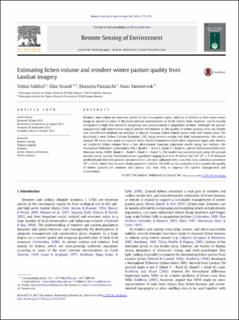| dc.contributor.author | Falldorf, Tobias | |
| dc.contributor.author | Strand, Olav | |
| dc.contributor.author | Panzacchi, Manuela | |
| dc.contributor.author | Tømmervik, Hans | |
| dc.date.accessioned | 2023-06-19T12:19:46Z | |
| dc.date.available | 2023-06-19T12:19:46Z | |
| dc.date.created | 2013-11-06T13:45:26Z | |
| dc.date.issued | 2014 | |
| dc.identifier.citation | Remote Sensing of Environment. 2014, 140 573-579. | en_US |
| dc.identifier.issn | 0034-4257 | |
| dc.identifier.uri | https://hdl.handle.net/11250/3072068 | |
| dc.description.abstract | Reindeer and caribou are keystone species in the circumpolar region, and rely on lichens as their main winter forage to survive in some of the most extreme environments on Earth. Lichen mats, however, can be heavily overgrazed at high deer densities, triggering area abandonment or population declines. Although the species' management and conservation require precise information on the quality of winter grazing areas, no reliable and cost-efficient methods are available to date to measure lichen volume across wide and remote areas. We developed a new Lichen Volume Estimator, LVE, using remote sensing and field measurements. We used a Landsat TM land cover mask to separate lichen heath communities from other vegetation types and, therein, we predicted lichen volume from a two dimensional Gaussian regression model using two indexes: the Normalized Difference Lichen Index, NDLI (Band 5−Band 4 / Band 5+Band 4), and the Normalized Difference Moisture Index, NDMI (Band 4−Band 5 / Band 4+Band 5). The model was parameterized using 202 ground measurements equally distributed across a gradient ranging from 0 to 80 lichen dm3/m2 (R2=0.74 between predicted and observed ground measurements), and was validated with a ten-fold cross validation procedure (R2=0.67), which also showed a high parameter stability. The LVE can be a valuable tool to predict the quality of winter pastures for reindeer and caribou and, thus, help to improve the species' management and conservation. Remote sensing Habitat mapping Reindeer Lichen volume and biomass Winter pastures | en_US |
| dc.language.iso | eng | en_US |
| dc.rights | Navngivelse-DelPåSammeVilkår 4.0 Internasjonal | * |
| dc.rights.uri | http://creativecommons.org/licenses/by-sa/4.0/deed.no | * |
| dc.subject | Remote sensing | en_US |
| dc.subject | Habitat mapping | en_US |
| dc.subject | Reindeer | en_US |
| dc.subject | Lichen volume and biomass | en_US |
| dc.subject | Winter pastures | en_US |
| dc.title | Estimating lichen volume and reindeer winter pasture quality from Landsat imagery | en_US |
| dc.type | Peer reviewed | en_US |
| dc.type | Journal article | en_US |
| dc.description.version | publishedVersion | en_US |
| dc.rights.holder | © 2013 The Authors | en_US |
| dc.subject.nsi | VDP::Matematikk og Naturvitenskap: 400::Zoologiske og botaniske fag: 480 | en_US |
| dc.source.pagenumber | 573-579 | en_US |
| dc.source.volume | 140 | en_US |
| dc.source.journal | Remote Sensing of Environment | en_US |
| dc.identifier.doi | 10.1016/j.rse.2013.09.027 | |
| dc.identifier.cristin | 1063404 | |
| cristin.unitcode | 7511,2,0,0 | |
| cristin.unitcode | 7511,4,0,0 | |
| cristin.unitname | Avdeling for terrestrisk økologi | |
| cristin.unitname | Tromsø | |
| cristin.ispublished | true | |
| cristin.fulltext | original | |
| cristin.qualitycode | 2 | |

